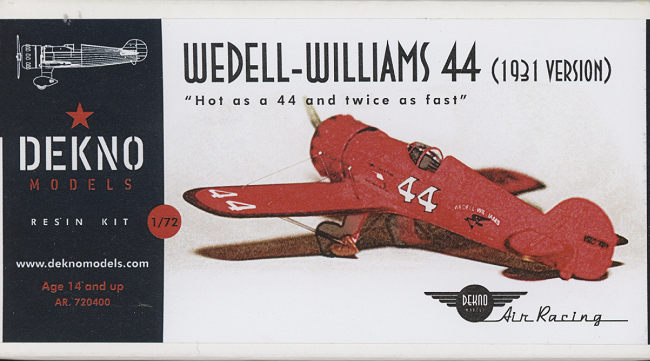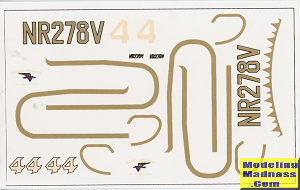
Dekno 1/72 Wedell-Williams Model 44
| KIT #: | GA 720400 |
| PRICE: | $35.00 |
| DECALS: | One option |
| REVIEWER: | Scott Van Aken |
| NOTES: | Resin with vacuformed clear parts |

| HISTORY |
The Wedell-Williams Model 44 is a racing aircraft, four examples of which were built in the United States in the early 1930s by the Wedell-Williams Air Service Corporation. It began as a rebuilding of the partnership's successful We-Will 1929 racer, but soon turned into a completely new racing monoplane aircraft, powered by a large radial engine. Model 44s became the dominant racers of the 1930s, setting innumerable records including setting a new world speed record in 1933.
The only surviving Model 44 is on display at the Crawford Auto-Aviation Museum, Cleveland, Ohio. Three replica Model 44s are on display at the Louisiana State Museum, Patterson, Louisiana.
In 1931, Wedell built a modified version of his most successful type to date and named the "Model 44". When mated with a Pratt & Whitney Wasp Jr. engine, the design's true potential began to be realized. That year, the "44" placed second at the National Air Races.
Soon after the '31 Nationals, Wedell began rebuilding the 44 and the We-Winc as well as taking a contract to build a Model 44 for the famous aviator Roscoe Turner. On the second test flight of Turner's Model 44, the left wing experienced a structural failure and was destroyed in the ensuing crash. Piloting the aircraft himself, Wedell parachuted to safety. After this incident, the assistance of Howard Barlow, an aeronautical engineer, was obtained in the redesign of the wings. The second Turner racer was built with the new wing design and proved to be an exceptional performer. The other two Model 44s were rebuilt according to the new wing specification as test pilots had noted wing vibrations in both aircraft previously.
These three aircraft went on to dominate air racing for the next several years. Model 44s were raced in 1932, 1933 and 1934 Bendix Trophy races, as well as the 1934 Thompson and Shell Trophy. In September 1933 at the International Air Race in Chicago, the 44 piloted by Wedell set the new world speed record of 305.33 miles per hour. Flying a 44, Doug Davis won the 1934 Bendix Trophy, but crashed and was killed while leading the Thompson Trophy Race on September 3, 1934. Roscoe Turner won the Thompson Trophy in a 44 with a different engine, while J. A. Worthen placed third, also in a 44.
| THE KIT |
 Dekno
Models is a short run resin company out of Catalonia that specializes in US
interwar aircraft. These are mostly civil types as well as some racers. All
of their kits are most welcomed by enthusiasts of the genre as aircraft from
this time period are rarely kitted. While the Wedell-Williams has been done
in other scales, this may well be the first time for a 1/72 build.
Dekno
Models is a short run resin company out of Catalonia that specializes in US
interwar aircraft. These are mostly civil types as well as some racers. All
of their kits are most welcomed by enthusiasts of the genre as aircraft from
this time period are rarely kitted. While the Wedell-Williams has been done
in other scales, this may well be the first time for a 1/72 build.  Instructions are a small folded sheet with well drawn construction steps
on one side and a painting and markings guide on the other.
Instructions provide interior color
information. The decals appear to be standard water slide. The builder will
need to paint the edges of the flight surfaces and the forward cowling gold
as having a decal try to wrap around those features would simply end up a
mess. The plane itself is a nice scarlet red and the instructions do provide
a rigging diagram. All of this fits neatly
into a box that looks like what I get large wooden matches in at the
hardware store. This is a neat way of packaging things in that the parts
tray simply slides out.
Instructions are a small folded sheet with well drawn construction steps
on one side and a painting and markings guide on the other.
Instructions provide interior color
information. The decals appear to be standard water slide. The builder will
need to paint the edges of the flight surfaces and the forward cowling gold
as having a decal try to wrap around those features would simply end up a
mess. The plane itself is a nice scarlet red and the instructions do provide
a rigging diagram. All of this fits neatly
into a box that looks like what I get large wooden matches in at the
hardware store. This is a neat way of packaging things in that the parts
tray simply slides out. | CONCLUSIONS |
Dekno does not release a lot of kits, but when it does, they are always highly anticipated and well worth the effort of picking up and building. I have built a few and they are not difficult at all if you have done a few resin kits in the past.
| REFERENCES |
https://en.wikipedia.org/wiki/Wedell-Williams_Model_44
November 2019 Copyright
ModelingMadness.com. All rights reserved.
If you would like your product reviewed fairly and fairly quickly, please contact the editor or see other details in the Note to Contributors.